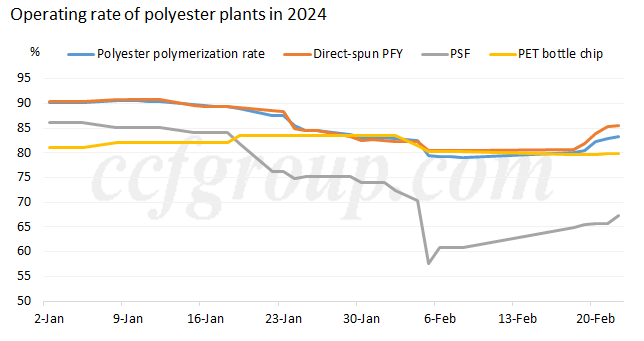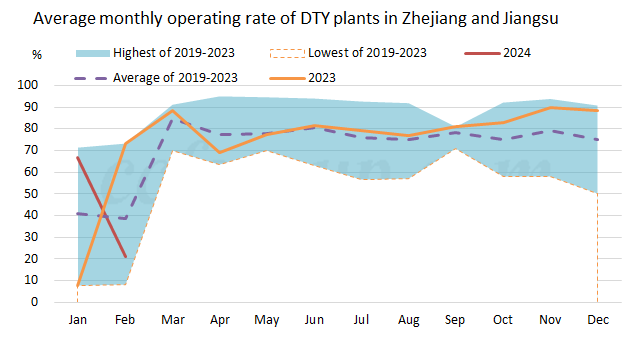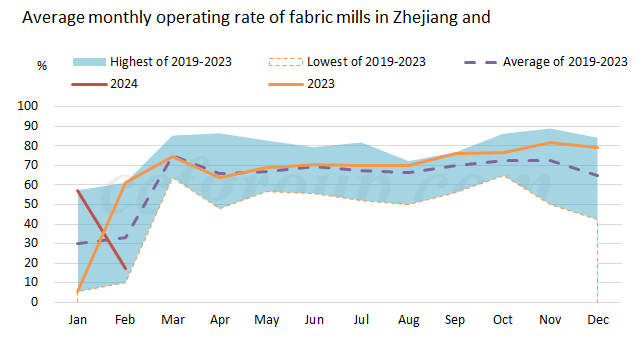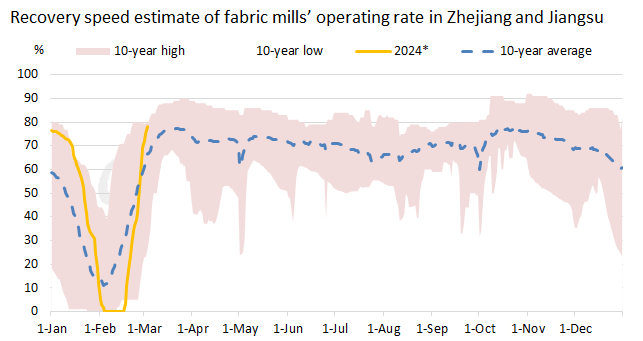Polyester and downstream factories busy in recruiting workers, recovering slower than estimation
On the first week after the Spring Festival holiday, the PFY factories and downstream sectors such as DTY plants, fabric mills and printing and dyeing union are busy in recruiting workers and resuming production. However, the pace of polyester product recovery and downstream processes is not fast, still constrained by the return of workers. Especially with the recent rain and snow weather in many parts of the country, some roads have turned into "ice rinks", affecting the return of workers.
It was reported that from 8:00 p.m. on February 21 to 8:00 p.m. on February 22, some areas in southern and eastern Tibet, southern Qinghai, southern Shaanxi, eastern and western Jianghuai, most of Jianghan, northern and western Hunan, northern Sichuan Plateau, northeastern Sichuan Basin, and northeastern Chongqing experienced moderate to heavy snow or sleet. As of 7:00 a.m. on the February 22, due to rain, snow, and icy road conditions, a total of 161 road sections were closed in Hebei, Shanxi, Inner Mongolia, Jiangsu, Anhui, Jiangxi, Shandong, Henan, Hubei, Hunan, Chongqing, Sichuan, Guizhou, Tibet, Shaanxi, Gansu, Qinghai, Ningxia, Xinjiang. Additionally, 2019 toll stations were closed, and the time for resuming traffic is yet to be determined.
According to the survey made by CCFGroup, the polyester polymerization rate increase to 83.2% by Feb 22, with the run rate of PFY plants, PSF producers and PET bottle chip factories at 85.6%, 67.3% and 79.8% respectively.
Operating rate of DTY plants, fabric mills and printing and dyeing plants advanced to 31%, 34% and 29% respectively in Zhejiang and Jiangsu: the run rate of DTY plants was at at 10-20% in Cixi, at 50-60% in Xiaoshan and Shaoxing, at 30-40% in Taicang, below 20% in Changxing, and around 30% in Changshu. The operating rate of water-jet fabric mills was at above 50% in Wujiang, at 30-40% in North Jiangsu and at 10-20% in Changxing; the run rate of warp knitting plants was above 70% in Haining and at 10-20% in Changshu. The run rate of circular knitting plants in Xiaoshan and Shaoxing from Zhejiang was at 10-20% and that of circular knitting plants in Changshu was below 10%. Operating rate of printing and dyeing plants was at 40-50% in Wujiang and North Jiangsu and at 20-30% in Xiaoshan, Shaoxing and Haining. Plants in Changshu and Changxing have not resumed operation temporarily.


The polyester polymerization rate is estimated to recover to be low 89% by end-Feb and the average polyester polymerization rate is expected to be around 82% in Feb, lower than pre-holiday estimate.
DTY, fabric manufacturing and printing and dyeing markets may be faster in recovering next week. The operating rate of DTY plants, fabric mills and printing and dyeing plants in Zhejiang and Jiangsu is anticipated to increase to lower than 80%, 70% and 60% respectively by end-Feb. The average operating rate of DTY plants, fabric mills and printing and dyeing plants in Zhejiang and Jiangsu is expected to be 17%, 21% and 14% respectively in Feb, which may recover to be high in early-Mar. The run rate of fabric mills in Zhejiang and Jiangsu may be as high as around 78% by that time.



In the short term, due to sufficient raw material inventory before the Spring Festival holiday and preparations for annual labor, the operating rate of downstream plants is expected to rise after holiday. However, the operating rate for March and April will be limited by downstream orders and the enthusiasm for stockpiling. The downstream orders are still uncertain at this point and are temporarily expected to be not very optimistic. On one hand, before the Spring Festival holiday, some downstream orders were expected to have increased transportation costs and were rushed, so there may be a certain amount of pre-positioning in downstream exports after the holiday. Additionally, there have been sporadic reports after the holiday of order cancellations or postponements due to increased shipping costs to Europe. However, the extent of this impact is currently difficult to assess. On the other hand, in the first half of 2024, domestic consumption is mainly focused on spring and summer products, while the production of autumn and winter products is mostly early preparation for goods. The orders related to spring and summer products is not worrying. However, the enthusiasm for stockpiling autumn and winter products may be limited by high raw material prices. Currently, affected by the "Red Sea" issue, there is a possibility of uptrend in oil prices, which could further drive up the prices within the entire polyester industry chain. The operating rate and inventory of the industry chain in April and May will ultimately be affected by downstream demand, so caution is advised.
- Top keywords
- Cotton Price
- Cotton Futures Price
- Cotton Futures
- CZCE
- PTA Futures Price
- Chemical Fiber
- Polyester Prices
- Wool price
- PTA Futures
- Shengze Silk
- China
- Yarn Price
- price
- China Textile City
- Fibre Price
- Benzene Price
- Cotton
- Index
- Cotton Index
- PTA
- fabric price
- NYMEX
- Top 10
- textile industry
- Spot Cotton
- Cotton Yarn
- Polyester Price
- Futures
- PTA Price
- cotton yarn price

